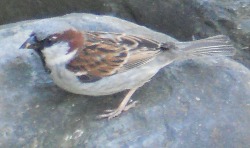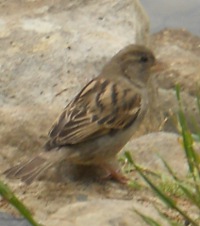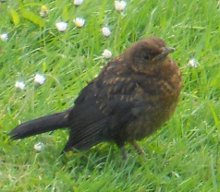British Birds
Contributions, research and write up by Israel. Page is a work in progress.
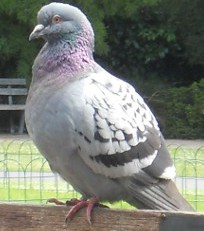
|
|
A proud rock pigeon. They were brought over and introduced along with (and as food for) the Kestrel. They survived and thrived. The Kestrel did not. |
Biritsh birds are so called as they are not natives to New Zealand, but introduced species, placed into NZ by the colonists in an effort to make the country feel a bit more like home. As their name suggests, they all originated from Great Britain, and introduced into our ecosystem mainly by Acclimatisation Societies, which were established in the 1860's (With the Otago and Canterbury society being established in 1864). Not all species survived (such as the Robin), while many others thrived. In bird shows these introduced birds have their own category, and the cross-breeding of some of the british birds with canaries is what gives rise to mules.
Not all non-native birds in New Zealand were introduced by humans. The changing landscape created by the actions of the settlers made NZ more friendly to some species, and they migrated here from other countries, such as the Silvereye, for which large flocks migrated here in the 1850's. This process is known as Self-Introduction. Other recent self introduced species include the spur-winged plover, the white-faced heron, the welcome swallow and the australian coot.
DID YOU KNOW:
A total of 144 bird species were introduced to NZ by humans, between ~1840 and now. Of these, only 33 species survived, and are now counted amongst NZ's avifauna. According to a paper by Kazimierz Wodzicki and Shelley Wright, 7 species were introduced for biological control, 9 as game birds, and 10 for sentimental reasons (things like they looked pretty, or reminded the homesick colonists of home and so forth). Reasons for the last 6 have been lost to time.
Of the introduced birds, the following can be shown in bird shows under the British Bird Category:
Hard Bills:| Goldfinch | Greenfinch | Chaffinch | Redpole |
| Yellow Bunting | Cirl Bunting | House Sparrow |
| Blackbird | Song Thrush | Hedge Sparrow | Sky Lark |
| Starling |
Species
Use the buttons below to jump to the species of interest
Goldfinch Greenfinch Chaffinch Redpoll Sparrow Dunnock Blackbird Song Thrush Starling
Out of the showable British Birds, not all are found in Dunedin, and some are much more common than others. From my experience at shows thus far, only a few birds are shown in this category, and there are bound to be numerous reasons for this. Most breeders will start with wild birds, and it can take generations to breed out the wild instincts. Having said that, some are more than happy to live in aviaries with a constant assured supply of food, and have been known to break in to make themselves at home then refuse to leave!
House Sparrows
The House Sparrow, commonly known just as the Sparrow, was introduced to NZ between 1866 to 1871, probably as a control measure against insects. Since then they have quite happily spread throughout most of NZ, except for in native bush and alpine regions, which aren't to their tastes. They are quite plentiful around human habitation, having adapted well to the environments that we create around us, and can easily be found in both urban and rural settings. In many areas they are even considered a pest (as they can cause significant damage to crops)! Sparrows are so common that many people don't give them a second thought or realise that these beautiful birds can be bred and showed.
|
|
House Sparrows (Passer domesticus) are a member of the Passeridae sparrow family, part of the Passeriformes order (aka Perching Birds), which makes up about 1/2 of all bird species. In many other countries, the house sparrow can be confused with other sparrows from the Passer genus (of which there are 25), but fortunately, being the only member of its genus in NZ, that is not a problem we have to worry about.
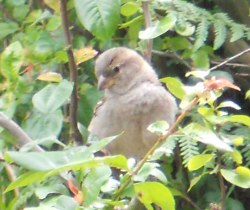
|
|
| Juvenile Sparrow in a rose bush. |
As can be seen in the above photos, females are a plainer brown then the males and lack the grey/white and black around the face, making them easy to sex. Sparrows are generally monogamous, and usually mate for life, though flings can occur outside of this during breeding season (with ~15% of fledglings being unrelated to their mothers partner [source: wikipedia]). Sparrows are a gregarious bird, and nesting sites can often be found clumped together in the same area. Male sparrows are the nest builders, constructing the nest in a hole in a tree, building or other location that they find suitable (including nests of other birds or from previous years), going about their construction or occupation before the breeding seasons starts. Many is the sparrow who has built their nest in the side of a house or under its roof! If without a mate, they will then sing frequently to attract a female, and their version of courting begins. Of course if they already have a mate then the start of the breeding season is much simpler.
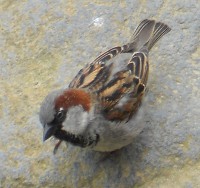
Sparrows are mainly seed eaters, though they do consume fruit and nectar. During breeding season they use live food (aka insects and such) as feed for the chicks (for the protein).This diet is similar to that of many caged birds, minus the live food which is usually only needed for some finches, hence why sparrows quite readily adapt to aviaries. They are also opportunistic and adaptable feeders, and will consume what is available when available. At picnic and eating areas, Sparrows can be found hoping around picking up the crumbs off the ground, and looking up cutely at the eating humans, hoping that they might throw them a larger piece of their sandwich (and often we oblige!).
In recent times, in many parts of the world, the population of House Sparrows has been decreasing (apparently they are almost gone from parts of London [source]), due to many factors. Fortunately House Sparrows are still common in Dunedin, helped in part by the structure and makeup of the city.
DID YOU KNOW:
The typical lifespan for a House Sparrow in captivity is 12-14 years. The record for the oldest wild House Sparrow is 19yrs, while the oldest House Sparrow in captivity lived for 23yrs.
House Sparrows are quite keen on bathing, though often they'll take dust baths instead of wet ones. The actions and effect is the same, throwing up a small cloud of dust with their wings over them to clean their feathers and skin. Like many birds of their family, they hop around instead of walking (it's related to the length of their legs, and energy efficiency, and other factors - you can read an interesting article on it here).
In aviaries, from the experience of those in the bird club, House Sparrows can generally be kept with other birds without any issues. House Sparrows have 2 known mutations/varieties - Pied & Fawn.
Dunnock

|
|
|
Dunnock at the Dunedin Botanic Gardens (also below). They are banded as part of a study. |
The Hedge Sparrow, also commonly known as the Dunnock (comes from ancient british and means small brown one), is as its name suggests a small brown bird. Though at a glance one could think that the House and Hedge sparrow were related, they come from a different family, and are in all ways quite different birds. Introduced in 1867 - 1882, the Prunella modularis has spread over all of New Zealand, though not in particularly large numbers. The Dunnock is most common in the eastern South Island (hence including Dunedin!).
Dunnocks feed mostly on invertebrates (insects and the like), though they do consume some seed and fruits. They prefer nesting in hedges, thick undergrowth and the like (hence their name), and hence are not as common in built up urban areas. Both sexes look very similar to each other.
Unlike most birds, Dunnocks don't just have one partner, but often multiple for both partners (so they practice monogamy, polyandry, polygyny, and polygynandry). It can get quite complicated, and different setups work better for males than for the females and vice versa. The time each male spends helping a female with her chicks is proportionate to how much success he had mating with her, so for females it is in their interest to court multiple mates, while on the other hand males like a bit more exclusivity. This mating behaviour seems to be a feature of the Dunnocks, and the feature of many articles on them. In terms of territory, females are exclusive (they don't mix), but males are likely to overlap, especially if they are servicing the same hen, and will cooperate to defend that patch. The range of the females (dependant on the availability of food) also has an influence on their mating patterns. In the Botanic Gardens in Dunedin, most of the Dunnocks have been banded as part of some research into the Dunnocks mating practices [ODT Article]. Overseas Cuckoos parasite Dunnocks nests, but at this stage this does not seem to be an issue in NZ as the cuckoos target the nests of other birds.
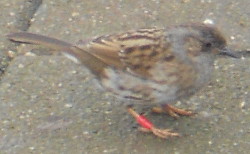
Outside of breeding season, Dunnocks are mostly solitary birds.
In captivity, Dunnocks can be somewhat of an issue. Given their territorial nature (and the sizes of them), and their natural hierarchy (older males are generally the alpha) they will often try to enforce this on the birds around them. From the experience of club members, even young Dunnocks will attack other birds, pulling and stripping feathers in an effort to assert their superiority, and during breeding season they will attack other birds nests, killing the young. Kept alone, however, they should be fine, though given that their diet is live food heavy, they do require more effort to keep than those birds that are seed heavy in diet.
Blackbird
The Black bird (Turdus merula), also known as the Common Blackbird, was introduced to New Zealand during 1862 to 1875. They quickly spread throughout NZ and can be found anywhere in the country, though they are less common in dense native bush and alpine regions. They have adapted quite well to the environment changes brough about by humanity, and while not to the same extreme as Sparrows, they are still quite common in parks and gardens. As can be seen in the images below, male Blackbirds are, as their name suggests, a deep black colour, while the females ar a plainer brown colour. Immature Blackbirds are similar to the female, though with a more mottled brown coat.
|
|
Blackbirds eat invertebrates (insects, worms and the likes) and fruit, and can often be seen rummaging around piles of dead leaves and undergrowth for a tasty meal, or stalking between the stalks of grass, especially when the ground is wet.
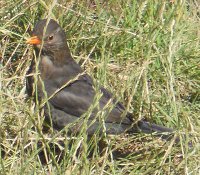
|
| Female Blackbird |
Blackbirs are somewhat territorial, especially during breeding season, but outside of breeding season they are more gregarious than they are during. Both male and female blackbirds will chase away threats to their nests, and it has been known for a blackbird to chase a cat when it got too close to comfort to their young!
Blackbirds are mostly monogamous, and pairs will stay together while both are still alive. They prefer to build their nests in dense scrub, bushes or trees, utilizing grass and mud.
Blackbirds both run and hop, as the need arises, and are usually very active birds. However they do seem to have the habit of flying low over roads at the wrong moments, either passing over or leaving from, and as a result many are lost to vehicles.
Chaffinch

|
| Male Chaffinch |
Chaffinch's (Fringilla coelebs) are a beautiful bird that were introduced to New Zealand between 1862 - 1880. They have spread over all of New Zealand and can be found in all parts of the country, though they are more common in urban and suburban areas. As is typical for birds the male is rather colourful (red-brown and grey colouring, with black and white bars on the wings), while the female lacks the red-brown and grey, having a tan brown colour instead. Though the Chaffinch has sub-species, like most of the introduced species they are not present in NZ. They are one of the four finch species in NZ (all of which were introduced).

|
|
| Female Chaffinch |
The nest of the Chaffinch is built in trees, in forks or on branches, and they typically camouflage it with lichen. Their diet consists mostly of seeds, but they raise their young on live food (insects and the like) which is an important consideration when keeping them in aviaries. Chaffinch's have been recorded to live up to 14 years. Overseas during winter the females migrate while the males often stay put.
In captivity, male Chaffinchs are very aggressive to each other, and if left in the same cage or aviary they will fight to the death (as has been the experience of some of the club members). Hence they are best left kept apart.
Goldfinch
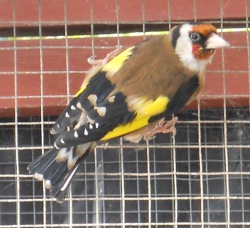
|
|
|
Goldfinch male |
There are four different species of Goldfinch, and the one common in New Zealand is the European Goldfinch (Carduelis carduelis). They can be found over most of New Zealand (especially in open country) but not in native bush (and high mountain regions obviously - as a result they aren't usually found on the west coast of the south island). Goldfinch diets consist mostly of seeds, and can often be found in a fanciers aviary with other birds. They are one of the two main favoured species for cross-breeding with canaries to create mules. In the wild Gold finches like to build their nests in small trees or shrubs/vines. When raising young they like to use live-food, but when cross-breeding as the female is usually a canary this isn't as essential.
Goldfinches have a black and white head, with a red face (which is smaller on the female), brown body with a black tail with white spots and a yellow bar. Rump is white. The Goldfinch was introduced into New Zealand between 1862-83, and were wide spread by the turning of the century.
Greenfinch

|
|
|
Green Finch Photo by Sheryl Braun |
Like the Goldfinch there are a number of varieties of Greenfinch, and the one that can be found in New Zealand is the European Greenfinch (Carduelis chloris). Greenfinches can be found all over New Zealand except for the west coast of the south island, and they are not common in native bush, prefering the open country. Females are browner in colour than the males, the species being an olive-green colour. They were introduced to New Zealand between 1862-68.
Greenfinches are mainly seed eaters, though they do use live food when raising chicks. In the wild they build their nests in small trees or on top of dense shrubs. Greenfinches are the other species that are commonly used for breeding mules with canaries.
Redpoll
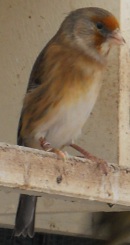
A member of the finch family, the Common Redpoll (Carduelis flammea) is a brown coloured bird with a deep red crown and forehead. During the breeding season their breast can also go a red colour as well. Interestingly enough, when kept in captivity Redpolls lose their red colouring, and the assumption is that this is related to environmental factors - i.e. that they are no longer getting the food required to give them the red colour. They can be colour-fed (like red-factor canaries) but this is penalised in bird shows. Female Redpolls do not have as large a red crown and lack the red on the breast.
Redpolls were introduced to New Zealand between 18626-75, becoming widespread by the turn of the century. They can be found over most of the country (including the west coast of the south island), are more common in the south island than the north, and are comfortable in anything from coastal to sub-alpine areas. They can be most easily seen in open areas.
Redpolls are primarily seed eaters, and build their nests in low shrubs.
Song Thrush
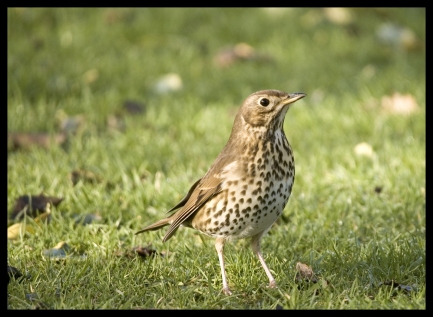
|
| Photo by Rob Simpson for the Dunedin Bird Club photo competition 2012. |
The Song Thrush (Turdus philomelos) is of the same genus as the blackbird, the True Thrush family. Introduced to New Zealand during 1862-78, they can now be found pretty much anywhere in the country and seem to thrive just fine in urban areas. Song Thrushes can easily be identified by there streaked underbelly, as can be seen in the image.
Song Thrushes build mud or rotten wood lined nests in dense vegetation, shrubs and the like, and their diet consists of invertebrates (like snails which they they enjoy smashing against their favourite rock once they learn the trick), fruits and some seeds, and they can often been seem foraging amongst piles of dead leaves or hopping across wet fields pulling up earth worms.
The Song Thrush was introduced to both New Zealand and Australia, and while it has thrived well here, it did not do so well in Australia, and can only be found in pockets around Melbourne. According to the wikipedia entry Song Thrushes have a wide variety of 'phrases', and they can learn the calls of neighbouring birds, captive birds, and some man-made objects - i.e they have the ability to mimic.
Song Thrushes are not generally a social bird. They are territorial and monogamous.
Starling
The Starling that we find in New Zealand is the European or Common Starling (Sturnus vulgaris), and was introduced between 1862-83. It can now be found over most of the country, except in native bush and alpine areas (so unlikely to be seen on the west coast of the south island). Starlings feed on invertebrates as well as fruit and nectar. They have a glossy coat, which in winter takes on white spots.
Starlings are walkers rather than a hoppers, and they build their nests in holes in trees, cliffs, buildings and so on. They are highly social birds, and are usually seen in flocks (murmurations). Overseas these murmurations can be quite massive, and can lead to natural phenomenons (such as Sort sol).
Acquiring British Birds
Under New Zealand law all native birds are protected species, as well as a number of the introduced species. However, all of the british birds that can be shown in shows are not protected species, and hence can be kept as pets / aviary birds in NZ, and captured from the wild. The Law that governs this is The Wildlife Act 1953, and its amendment in 2010 that changed protection status of a number of species. The list of all the species that are not protected can be found in Schedule 5 of the act.
There are three main ways that one can acquire british birds:
- by chance - they ahve been known to fly into an aviary by chance
- acquire from someone who already has a stock of them - either a petshop or breeder (who has either caught their stock or bred them from previous stock)
- catch your own
Obviously the first two are the easiest. Breed british birds are also the easiest to fit into an existing aviary stock as they are familiar with that setup, but someone somewhere has to start with catching them from the wild. There are numerous ways in which to catch wild birds, and it comes down to personal experience. If one is really fast and keen a net might be a possibility (though probably likely to be unsuccessful), more common is a cage structure and bait. Patience and time is the key, but the reward will be well worth the effort.
Keeping Particulars
There are a number of factors that need to be considered when keeping birtish birds, in particular if they are wild caught ones (and they suddenly have had a change of environment!).
- If they didn't choose the option themselves Stress can be a lethal factor when they find themselves in an enclosure. Of course the bigger the aviary the better for mitigating this factor, but it often will come down to the individual bird and what birds they are in the company with.
- Following on from that, what other birds they are with is important to consider. Some birds are social, others are not, and if the wrong ones are mixed you'll likely end up with more casualties than you'd wanted (for example Dunnocks don't mix well). Tied in with that is familiarity, both with other birds and the environment in which they find themselves (and it applies to all other birds as well) - the more familiar they are with other birds or the aviary the easier they will settle in.
- It can take some time to adjust to the change in diet. Most of the seeds that we feed our birds don't grow in the wild, and while some species will quickly adapt others will take much longer. It is also important to make sure that there is variety in their diet and they get some sort of substitute for foods that they would have eaten in the wild - such as protein, fruits and so on.
- They can also take time to get used to their new source of water!
- Perching locations can cause conflict between birds, as some will like to bathe in the sun, or perch in particular locations. They will sort this out over time, but it is good to provide birds in an aviary with a variety of perching locations to cater for different needs.
- hence Set-up is very important. The aviary needs to be suitable for the type of birds you are keeping, both in size, shape, location, and what interior decorating you use.
- ...there will of course be other factors as well, and as in all things experience is the key. If you are new to british birds, then finding someone in your local club who has had experience or knows someone with experience is always a good step to take.
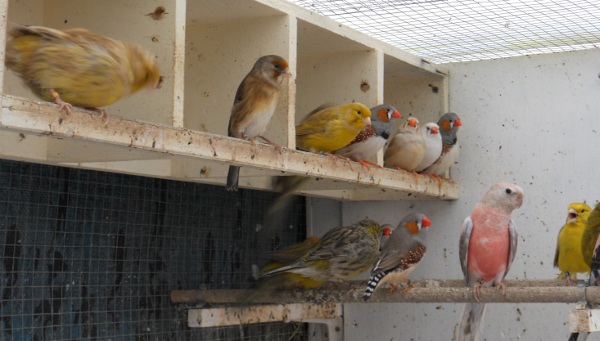
|
|
| A mixed aviary, including british. |
Breeding
Breeding with british birds is very similar to breeding with other birds. The main considerations to take are what kind of nest do they make in the wild (so make sure suitable nesting locations and material are provided) and what sort of foods do they like to use when rearing their young. Some of the british birds like to use live food when raising chicks, and if this is not catered for in some way you may end up losing all of your young.
Hybrids
A british hybrid is the offspring of two british birds, the most common combination being Greenfinch crossed with Goldfinch. It should be noted that some of the 'british birds' species are not compatible with others for breeding purposes (you cannot breed a thrush variety with a finch variety for example) and hence the pairs are usually selected from with the same genus. Goldfinches, Greenfinches, and Redpolls are all part of the Carduelis genus, while Blackbirds and Song Thrushes are both of the Turdus genus.
So, following on from that basis the following combinations have been recorded as being successful for breeding young (format is male x female):
- Goldfinch x Greenfinch
- Goldfinch x Redpoll
- Goldfinch x Chaffinch
- Greenfinch x Goldfinch
- Greenfinch x Redpoll
- Greenfinch x Chaffinch
- Redpoll x Goldfinch
- Redpoll x Greenfinch
- Blackbird x Song Thrush
- Song Thrush x Blackbird
As can be seen in the above table, Chaffinch males do not pair well with other species, and though Chaffinches come from a different genus they can be bred with the Carduelis genus.
When breeding for hybrids (and mules) it is essential that no other suitable partners of the same species are kept in the same cage, as they will just mate with them as they naturally would. For example, if you had a male and female goldfinch and a female greenfinch in the same cage then the two goldfinches will mate, and the greenfinch would be ignored. In order to mate the goldfinch and greenfinch together the other goldfinch would have to be removed. Like all pairings, familiarity between the birds is very useful, so keeping them together before breeding season starts will increase the chances of success.
Different species of birds come into season at different times, and this also needs to be accounted for. If the hen comes into season before the male, it may be useful to have the hen have a clutch via a male from her own species first, and have the intended father help raise them so that once they are fledged he'll be in season and she'll be all prepared for he second round. Having a large cage or plenty of distractions will also help the survivalability of the eggs will they hatch. Using mules as an example, if you wanted to breed a goldfinch male with a canary hen, but she comes into season well before he does, it may be worth letting her have a clutch via another canary, but have the goldfinch male help rear the chicks from that first clutch before they then have one together. When they aren't together it is good to still have her in sight of him.
Miscellaneous Information
Surviving Introduced Bird Species in NZ
| Blackbird | Song Thrush | Hedge Sparrow (Dunnock) | House Sparrow |
| Goldfinch | Greenfinch | Starling | Redpole |
| Skylark | California Quail | Black Swan | Mallard Duck |
| Yellowhammer | Chaffinch | Kookaburra | Malay Spotted Dove |
| Barbary Dove | Crimson Rosella | Eastern Rosella | White Cockatoo |
| Cirl Bunting | Brown Quail | Pheasant | Little Owl |
| Peafowl | Chukor | Mute Swan | Feral/Rock Pigeon |
| Rook | Black-backed Magpie | White-backed Magpie | Canada Goose |
| Myna |
Useful Links
Wikipedia entry for House SparrowsWikipedia entry for Dunnocks
Wikipedia entry for Blackbirds
Wikipedia entry for Chaffinchs
Wikipedia entry for Goldfinch
Wikipedia entry for Greenfinch
Wikipedia entry for Redpoll
Wikipedia entry for Song Thrush
Wikipedia entry for Common Starling
